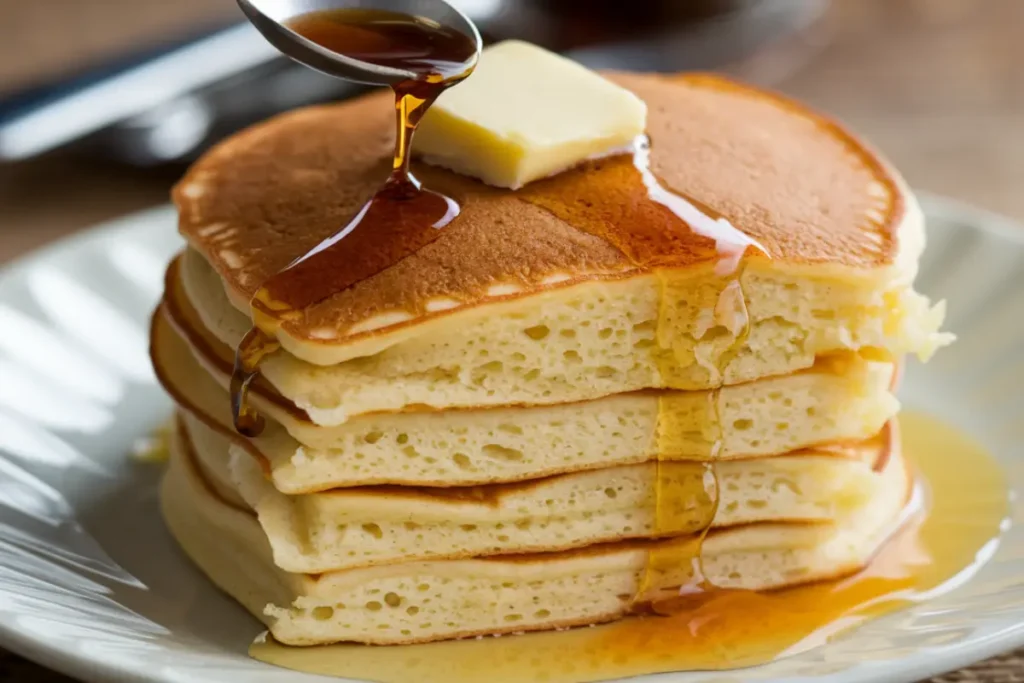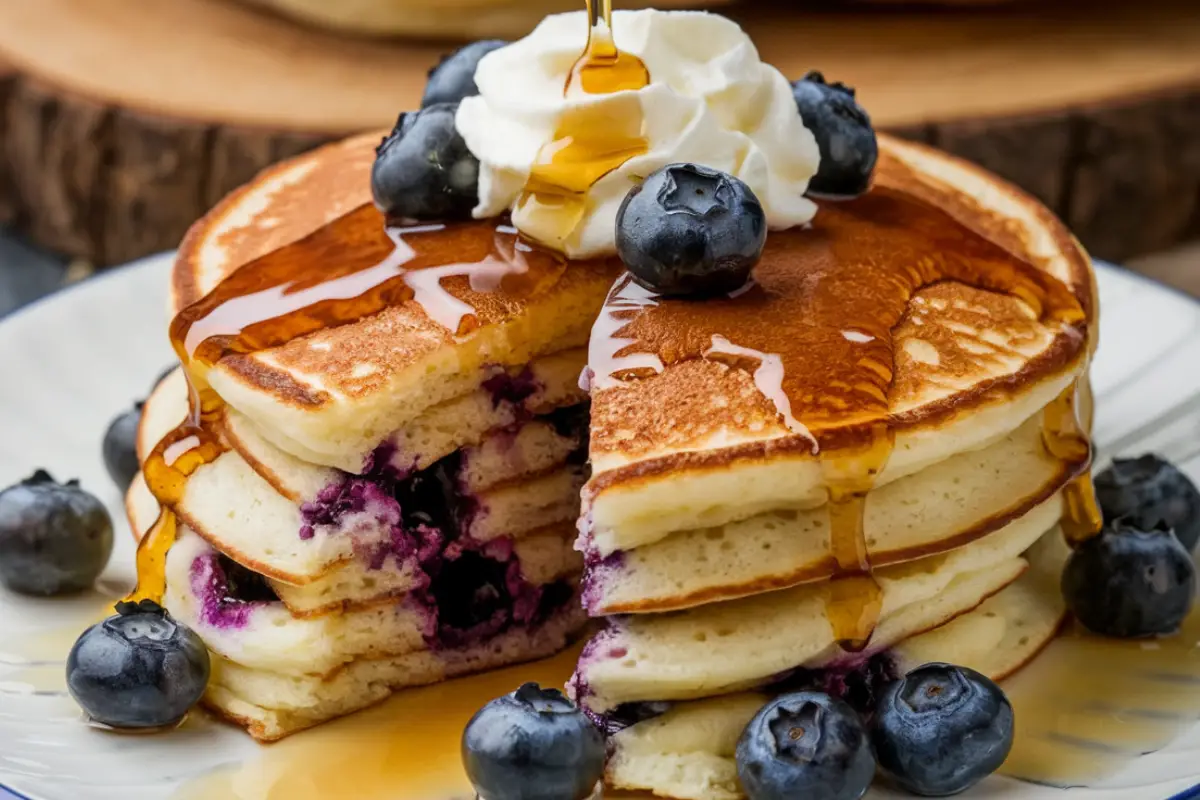If you’re on the hunt for the perfect gluten free pancake recipe, you’ve come to the right place. These pancakes aren’t just a substitute—they’re a delightful breakfast in their own right. Whether you’re gluten intolerant or just looking to explore gluten-free options, this recipe is your ticket to fluffy, golden perfection. Ready to dive in? Let’s make some pancakes!
Essential Ingredients for Gluten-Free Pancakes
A great gluten free pancake recipe starts with the right ingredients. Here’s what you’ll need:
- Gluten-Free Flour Blend: The heart of your recipe. Look for blends that include rice flour, potato starch, and tapioca flour for a balanced texture. These blends often contain xanthan gum or guar gum to mimic the binding properties of gluten.
- Baking Powder: This helps your pancakes rise and become fluffy. Ensure it’s gluten-free; many brands are, but it’s always good to check.
- Milk: Use dairy or a dairy-free alternative like almond milk. If you prefer, you can use buttermilk or even coconut milk for a different flavor profile.
- Eggs: They provide structure and richness. If you’re vegan or have an egg allergy, you can use egg replacers like flax eggs or chia seeds mixed with water.
- Sugar: For a touch of sweetness. Adjust the amount to your taste or use alternatives like honey or maple syrup.
- Salt: Just a pinch to enhance the flavors. It helps to balance the sweetness and brings out the other ingredients.
- Butter or Oil: For cooking and a bit of richness in the batter. You can use coconut oil, avocado oil, or even vegetable oil.
Feel free to experiment with your favorite gluten-free flour blend to find what works best for you.

How to Achieve Fluffy Gluten-Free Pancakes
Fluffy pancakes are the ultimate goal, and with the right technique, you can achieve just that. Here’s how:
- Use the Right Flour Blend: A high-quality gluten-free flour blend will make a huge difference. Look for ones that include a mix of rice flour, potato starch, and tapioca flour, as these provide the best texture and rise. If you’re curious about making your own blends, check out this guide on gluten-free flour types for some tips.
- Don’t Overmix the Batter: Overmixing can make pancakes dense. Mix until just combined; lumps are okay. Overmixing incorporates too much air and gluten-free flour blends can become gummy if overworked.
- Let the Batter Rest: Letting the batter sit for about 10 minutes allows the flour to absorb the liquid and helps the pancakes rise. It also helps the gluten-free flours hydrate fully, resulting in a smoother texture.
- Preheat Your Pan: Ensure your pan or griddle is hot before pouring the batter. A medium heat works best. If the pan is too hot, the pancakes might burn on the outside while remaining raw inside.
Step-by-Step Gluten-Free Pancake Recipe
Ready to make your own batch? Follow this simple recipe for perfect pancakes every time.
Ingredients:
- 1 1/2 cups gluten-free flour blend
- 2 tablespoons sugar
- 1 tablespoon baking powder
- 1/2 teaspoon salt
- 1 1/2 cups milk
- 2 large eggs
- 2 tablespoons melted butter or oil
Instructions:
- Mix Dry Ingredients: In a large bowl, whisk together the gluten-free flour blend, sugar, baking powder, and salt. This ensures the leavening agents are evenly distributed throughout the batter.
- Combine Wet Ingredients: In another bowl, mix the milk, eggs, and melted butter or oil. Whisk until the mixture is well combined.
- Combine Wet and Dry: Pour the wet ingredients into the dry ingredients and stir until just combined. The batter will be slightly lumpy—this is normal. Don’t overmix; it’s better to have a few lumps than to overwork the batter.
- Heat the Pan: Preheat a non-stick skillet or griddle over medium heat. Lightly grease with butter or oil. Use a paper towel to spread a thin layer of oil over the pan.
- Cook Pancakes: Pour 1/4 cup of batter onto the hot pan for each pancake. Cook until bubbles form on the surface, then flip and cook until golden brown. Adjust the heat as needed to ensure even cooking.
- Serve and Enjoy: Serve hot with your favorite toppings like fresh berries, maple syrup, or a sprinkle of powdered sugar. Try adding a dollop of whipped cream or a drizzle of chocolate sauce for an extra indulgent treat.
Troubleshooting Common Issues with Gluten-Free Pancakes
Even with the best recipe, you might run into a few hiccups. Here’s how to tackle common issues:
- Dense Pancakes: Ensure your baking powder is fresh and don’t overmix the batter. Let the batter rest for a bit before cooking. If your pancakes are dense, it could be because your flour blend doesn’t have the right balance of ingredients or your batter was mixed too much.
- Uneven Cooking: Make sure your pan is evenly heated. If pancakes cook too fast on the outside but stay raw inside, your pan may be too hot. Adjust the heat to medium and allow the pan to preheat properly.
- Batter Too Thick: Add a little more milk to reach the desired consistency. The batter should pour easily but not be too runny. If the batter is too thick, it will spread too slowly and cook unevenly.
- Pancakes Sticking to the Pan: Ensure your pan is well-greased and preheated. Use a non-stick spray or a small amount of butter to prevent sticking. Also, make sure not to flip the pancakes too early.
Gluten-Free Pancake Variations and Creative Ideas
Why stick to just plain pancakes? Here are some creative variations to try:
- Berry Pancakes: Fold in fresh or frozen berries into the batter for a fruity twist. Blueberries, raspberries, and strawberries are all great choices. You can also create a berry compote to drizzle on top.
- Chocolate Chip Pancakes: Add a handful of gluten-free chocolate chips for a sweet treat. The chocolate melts slightly, creating gooey pockets of deliciousness.
- Savory Pancakes: Try adding herbs and cheese for a savory breakfast option. Chopped fresh herbs like chives, parsley, or thyme, and a sprinkle of grated cheese can turn these pancakes into a hearty meal.
- Pumpkin Spice Pancakes: Add pumpkin puree and a blend of pumpkin spices (cinnamon, nutmeg, ginger) to the batter for a fall-inspired treat. These are perfect for cozy mornings.
- Banana Pancakes: Mash a ripe banana and mix it into the batter. This adds natural sweetness and a subtle banana flavor. For a fun twist, check out our banana bread recipe with cake mix.
- Nutty Pancakes: Add chopped nuts like pecans or walnuts to the batter for extra crunch and flavor. Toasting the nuts beforehand can enhance their flavor.
Storing and Reheating Gluten-Free Pancakes
Got leftovers? Here’s how to store and enjoy them later:
- Storing: Place cooled pancakes in an airtight container and refrigerate for up to 3 days. For longer storage, freeze them with parchment paper between layers to prevent sticking. Label the container with the date so you can keep track of how long they’ve been stored.
- Reheating: Reheat in a toaster, oven, or skillet. Avoid microwaving as it can make pancakes soggy. To reheat in the oven, place pancakes on a baking sheet and warm at 350°F (175°C) for about 5 minutes. In a skillet, reheat over medium heat for a few minutes on each side.
Nutritional Information for Gluten-Free Pancakes
While we’re not diving into health benefits, knowing the basic nutritional facts can be handy:
- Calories: About 150-200 per pancake, depending on size and ingredients. This makes it easy to estimate how many pancakes fit into your daily calorie needs.
- Fat: Around 6-8 grams per pancake. The fat content can vary based on the type of oil or butter used.
- Carbohydrates: Approximately 20-25 grams per pancake. Gluten-free flours often have slightly higher carbohydrate content compared to regular flour.
Common Questions About Gluten-Free Pancakes
Got questions? We’ve got answers!
- Can I Use Gluten-Free Pancake Mix? Absolutely! Just follow the package instructions for best results. Gluten-free pancake mixes are formulated to ensure good texture and flavor, often requiring just the addition of liquid and eggs.
- How Do I Make Pancakes Without Gluten-Free Flour Blend? You can use individual gluten-free flours like almond or rice flour, but the texture might vary. You’ll need to combine them with starches and binding agents to mimic the properties of traditional flour blends.
- Can I Prepare Pancake Batter in Advance? Yes, you can refrigerate the batter overnight. Just stir before cooking. This can be a time-saver for busy mornings. Be aware that the batter may thicken slightly; add a bit of milk if needed.
- Can I Freeze Pancake Batter? While you can freeze pancake batter, it’s generally better to freeze cooked pancakes. If you do freeze the batter, be sure to thaw it thoroughly and stir well before cooking.
- How Can I Make Pancakes Without Eggs? Use egg replacers like flax eggs or chia seeds mixed with water. Combine 1 tablespoon of ground flaxseed or chia seeds with 3 tablespoons of water per egg and let it sit for a few minutes to thicken.
Pancake Toppings and Accompaniments
Enhance your gluten-free pancakes with a variety of toppings and accompaniments:
- Maple Syrup: A classic choice. Opt for pure maple syrup for the best flavor and quality.
- Fresh Fruit: Berries, sliced bananas, or even apples sautéed in a bit of cinnamon make delicious toppings.
- Yogurt: A dollop of Greek yogurt can add a creamy texture and a bit of tang.
- Nut Butters: Almond, peanut, or cashew butter can provide a nutty flavor and extra protein.
- Whipped Cream: For a decadent touch, top with a bit of whipped cream.
Gluten-Free Pancake Recipe FAQ
Here are some frequently asked questions about gluten-free pancakes:
- Can I Use Almond Flour Instead of Gluten-Free Flour Blend? Almond flour can be used but will result in a different texture and flavor. You might need to adjust the recipe to account for the lack of binding agents present in gluten-free flour blends.
- How Do I Make Pancakes Crispy? For crispier edges, cook the pancakes at a slightly higher temperature and add a bit more oil to the pan.
- Can I Make Gluten-Free Pancakes Ahead of Time? Yes, you can make and freeze pancakes ahead of time. Just reheat them as needed for a quick and easy breakfast.
- What Should I Do If My Pancakes Are Burning? If your pancakes are burning, lower the heat and ensure your pan is evenly heated. You might need to adjust the temperature to find the right balance.
Conclusion
With this gluten free pancake recipe, you’re all set to enjoy a delicious, fluffy breakfast that everyone will love. Whether you’re sticking to a gluten-free diet or just exploring new options, these pancakes will hit the spot. So grab your ingredients, heat up your pan, and get ready for a breakfast that’s both tasty and satisfying.
